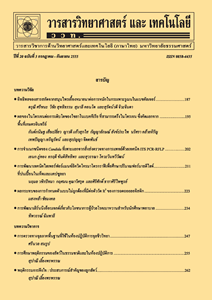แอฟฟล่าท็อกซินบี 1 ในวัตถุดิบอาหารข้นเยื่อใยสูงสำหรับโคนมที่เก็บไว้ในฤดูร้อน
Main Article Content
Abstract
บทคัดย่อ
การปนเปื้อนแอฟฟล่าท็อกซินบี1 (aflatoxin B1, AFB1) ในอาหารโคนมมีผลเสียต่อสุขภาพโค และการตกค้างในน้ำนมในรูปแอฟฟล่าท็อกซินเอ็ม1ส่งผลอันตรายต่อผู้บริโภค การวิจัยนี้มีวัตถุประสงค์เพื่อศึกษาอิทธิพลของระยะการเก็บรักษาในช่วงฤดูร้อน 8 สัปดาห์ต่อปริมาณ AFB1 และความชื้นในกากเบียร์แห้ง กากเนื้อในปาล์ม ใบกระถินป่น จากแหล่งผลิต (block) 2 แหล่ง โดยใช้แผนการทดลอง RCBD และทำการศึกษาอิทธิพลดังกล่าวในกากมะพร้าวและกากทานตะวันโดยใช้แผนการทดลอง CRD จำนวน 2 ซ้ำ ความชื้นสัมพัทธ์ในอากาศตลอดการทดลองมีค่าอยู่ในช่วง 56.14 ถึง 77.57 % อุณหภูมิอากาศต่ำสุด สูงสุด และเฉลี่ยในแต่ละสัปดาห์อยู่ในช่วง 25.43-28.86, 37.14-40.57 และ 31.51-34.72 องศาเซลเซียส ตามลำดับ จากการศึกษาพบว่าปริมาณ AFB1 ในกากเบียร์แห้ง กากเนื้อในปาล์ม และใบกระถินป่นไม่ต่างกัน (P>0.05) จากการเก็บรักษาในฤดูร้อน 8 สัปดาห์ และพบอยู่ในช่วง 8.51-18.78, 26.39-30.77, 96.7-110.52 ppb ตามลำดับ แหล่งที่มาของวัตถุดิบทั้ง 3 ชนิดนี้มี AFB1 ต่างกัน (P<0.05; 10.50 vs 14.27; 20.13 vs 37.90; 87.05 vs 119.61 ppb ตามลำดับ) ความชื้นวัตถุดิบทั้ง 3 ชนิดขณะเริ่มทดลองน้อยกว่า 6% และไม่พบความแตกต่าง (P>0.05) ในกากเบียร์แห้ง แต่พบเพิ่มขึ้น (P<0.05) ในกากเนื้อในปาล์มและใบกระถินป่นเมื่อระยะเวลาการเก็บรักษาเพิ่มขึ้น แหล่งที่มาของวัตถุดิบดังกล่าวมีความชื้นต่างกัน (P<0.05; 4.82 vs 6.92; 5.49 vs 6.30; 5.35 vs 7.05 % ตามลำดับ) กากมะพร้าวมี AFB1ไม่ต่างกัน(P>0.05) ขณะที่มีความชื้นเพิ่มสูงขึ้น (P<0.05) จากการเก็บรักษา 8 สัปดาห์ และพบอยู่ในช่วง 87.89-100.36 ppb และ 4.41-9.50 % ตามลำดับ กากทานตะวันมี AFB1 และความชื้นขณะเริ่มทดลอง 35.3 ppb และ 7.43 % และเพิ่มขึ้น (P<0.05) เป็น 42.09-43.99 ppb และ 7.68-9.27 % เมื่อเก็บรักษาไว้นานกว่า 3 และ 4 สัปดาห์ ตามลำดับ จากการศึกษานี้สรุปได้ว่าวัตถุดิบอาหารสัตว์ที่ทำการศึกษาสามารถถูกเก็บไว้ในฤดูร้อน 8 สัปดาห์โดยไม่มีการเพิ่มของ AFB1 ยกเว้นกากทานตะวัน AFB1 ที่ตรวจพบในวัตถุดิบทุกชนิดขณะเริ่มการทดลองเป็นข้อมูลที่บ่งชี้ถึงปัญหาการปนเปื้อน AFB1 ก่อนหรือขณะผลิตวัตถุดิบอาหารสัตว์แต่ละชนิด
คำสำคัญ : แอฟฟล่าท็อกซินบี 1; วัตถุดิบอาหารข้นเยื่อใยสูง; โคนม
Abstract
Aflatoxin B1 (AFB1) contamination in feeds adversely affects the dairy cattle health. Its residue in a form of aflatoxin M1 is hazardous to consumer. The aim of this research was to determine the effect of storage time for 8 weeks during summer on AFB1 and the moistures in brewer’s dry grain, palm kernel meal and leuceana leaf from 2 sources (blocks) in RCBD. The effect was also studied on AFB1 and moisture in coconut meal and sunflower meal in CRD with 2 replicates. Relative humidity during the studies ranged from 56.14 to 77.57%. Minimum, maximum and average temperatures ranged from 25.43 to 28.86, 37.14 to 40.57 and 31.51 to 34.72oC, respectively. There was no effect of the storage time (P>0.05) on AFB1 in brewer’s dry grain, palm kernel meal and leuceana leaf. AFB1 in these 3 feeds ranged from 8.51 to 18.78, 26.39 to 30.77 and 96.7 to 110.52 ppb, respectively. AFB1 in these feeds were different between sources (P<0.05; 10.50 vs 14.27; 20.13 vs 37.90; 87.05 vs 119.61 ppb, respectively). Moistures of these 3 feeds at the beginning of the studies were lower than 6%. Moistures were not different (P>0.05) in brewer’s dry grain but increased in palm kernel meal and leuceana leaf during 8 weeks. Sources of these 3 feeds had different moisture contents (P<0.05; 4.82 vs 6.92; 5.49 vs 6.30; 5.35 vs 7.05 %, respectively). When coconut meals were stored for 8 wks, AFB1 were not different (P>0.05) but moistures increased (P<0.05). AFB1 and moistures ranged from 87.89 to 110.41 ppb and 4.41 to 9.50 %, respectively. Sunflower meal had AFB1 and moisture at 35.3 ppb and 7.43% while the experiment was started. When stored for longer than 3 weeks, AFB1 increased to be at 42.09-43.99 ppb. Moistures also increased to be at 7.68-9.27 % when stored for longer than 4 weeks. In conclusion, all the feeds that were studied could be stored for 8 weeks during summer without increasing AFB1 except for the sunflower meal. Detected AFB1 in all feeds at the beginning of the studies suggested the contamination prior or during the feed processing.
Keywords: aflatoxin B1; high fibrous concentrate feeds; dairy cattle


